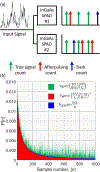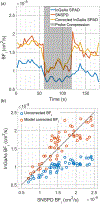Diffuse Correlation Spectroscopy Beyond the Water Peak Enabled by Cross-Correlation of the Signals From InGaAs/InP Single Photon Detectors
- PMID: 34847015
- PMCID: PMC9119938
- DOI: 10.1109/TBME.2021.3131353
Diffuse Correlation Spectroscopy Beyond the Water Peak Enabled by Cross-Correlation of the Signals From InGaAs/InP Single Photon Detectors
Abstract
Objective: Diffuse correlation spectroscopy (DCS) is an optical technique that allows for the non-invasive measurement of blood flow. Recent work has shown that utilizing longer wavelengths beyond the traditional NIR range provides a significant improvement to signal-to-noise ratio (SNR). However, current detectors both sensitive to longer wavelengths and suitable for clinical applications (InGaAs/InP SPADs) suffer from suboptimal afterpulsing and dark noise characteristics. To overcome these barriers, we introduce a cross correlation method to more accurately recover blood flow information using InGaAs/InP SPADs.
Methods: Two InGaAs/InP SPAD detectors were used for during in vitro and in vivo DCS measurements. Cross correlation of the photon streams from each detector was performed to calculate the correlation function. Detector operating parameters were varied to determine parameters which maximized measurement SNR.State-space modeling was performed to determine the detector characteristics at each operating point.
Results: Evaluation of detector characteristics was performed across the range of operating conditions. Modeling the effects of the detector noise on the correlation function provided a method to correct the distortion of the correlation curve, yielding accurate recovery of flow information as confirmed by a reference detector.
Conclusion: Through a combination of cross-correlation of the signals from two detectors, model-based characterization of detector response, and optimization of detector operating parameters, the method allows for the accurate estimation of the true blood flow index.
Significance: This work presents a method by which DCS can be performed at longer NIR wavelengths with existing detector technology, taking advantage of the increased SNR.
Figures







References
-
- Boas DA and Yodh AG, “Spatially varying dynamical properties of turbid media probed with diffusing temporal light correlation,” J. Opt. Soc. Am. A, vol. 14, no. 1, p. 192, Jan. 1997, doi: 10.1364/JOSAA.14.000192. - DOI
-
- Yazdi HS et al., “Mapping breast cancer blood flow index, composition, and metabolism in a human subject using combined diffuse optical spectroscopic imaging and diffuse correlation spectroscopy,” J. Biomed. Opt, vol. 22, no. 4, p. 045003, Apr. 2017, doi: 10.1117/1.jbo.22.4.045003. - DOI - PMC - PubMed
Publication types
MeSH terms
Substances
Grants and funding
LinkOut - more resources
Full Text Sources
Miscellaneous

